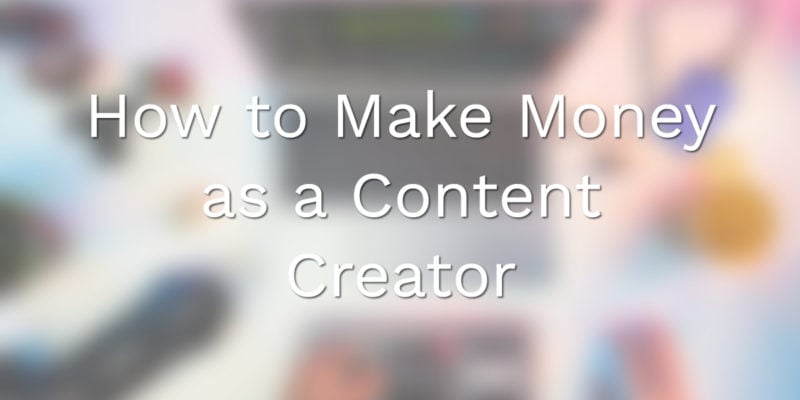You spent six hours creating your last Instagram Reel, and it barely hit 200 views. Meanwhile, your rent is due next week, and you’re starting to wonder if this whole “creator economy” thing is just a fantasy sold to people desperate to escape their 9-to-5. The algorithm feels rigged, your engagement is tanking, and you’re making roughly $1.50 per hour when you break down the actual math.
Here’s what nobody tells you: Goldman Sachs projects the creator economy will reach $480 billion by 2027, but only 4% of creators earn over $100,000 annually. The difference between creators struggling to pay bills and those building sustainable businesses comes down to understanding the 47 distinct monetization methods available—and knowing which ones to implement when you’re still building your audience.
This guide reveals the exact revenue strategies successful creators use to generate income at every stage, from your first dollar to building a six-figure business. More importantly, you’ll learn how to implement each strategy even when you’re working with limited time, budget, and audience size.
The Content Creation Reality Nobody Talks About

You’re creating content in the most challenging environment ever. Platforms change algorithms overnight, wiping out months of growth. TikTok creators saw reach drops of 60-80% after the July 2025 algorithm update. Instagram’s Reels Play Bonus program was quietly paused, cutting off a major income source for thousands of creators. YouTube’s new “inauthentic content” policy demonetized creators using template-based approaches.
ConvertKit’s 2024 Creator Economy Report found that creators using diversified income streams earned 3x more than those relying solely on platform monetization. For solo creators, that’s the difference between $500 monthly and $1,500 monthly recurring income. The creators surviving and thriving understand something crucial: platforms pay you to bring audiences, but real wealth comes from owning the relationship with that audience.
The harsh reality is that the average time to earn your first dollar as a creator is 6.5 months, and reaching self-supporting income takes 17 months on average. But armed with the right strategies, you can accelerate this timeline significantly.
Breaking Down Creator Income Reality
Here’s what successful monetization actually looks like across different stages:
- Months 1-6 ($0-$500 monthly): You’re building foundation while likely losing money on tools, equipment, and courses. Focus on audience building and testing initial monetization methods.
- Months 7-12 ($500-$2,000 monthly): Platform monetization kicks in, first brand partnerships appear, digital products start selling. You’re still working more hours than a traditional job but income is growing.
- Months 13-18 ($2,000-$5,000 monthly): Multiple revenue streams activate, systems start working without constant hands-on effort. You might finally match your previous job income.
- Year 2+ ($5,000-$15,000+ monthly): Business sophistication emerges. You’re not just a creator anymore—you’re running a media company with predictable revenue streams.
Platform Monetization Mastery

The foundation of every successful creator business starts with understanding how each platform actually pays creators. While diversification is crucial long-term, mastering platform-native monetization gives you the cash flow to invest in building your broader business empire.
You need to think strategically about platform selection based on your content style, audience demographics, and time investment required. A lifestyle creator might thrive on Instagram’s visual storytelling, while a business consultant could build faster on LinkedIn’s professional network.
YouTube: The Creator Cash Cow

YouTube remains the most lucrative platform for long-term creator income, but the rules changed dramatically in 2025. If you’re spending 8 hours editing one video and earning $20 in ad revenue, you’re approaching YouTube all wrong.
The platform now operates a two-tier Partner Program that smart creators exploit for maximum earnings:
Tier 1 Access (500 subscribers, 3,000 watch hours):
- Super Thanks: Viewers tip $2-$500 per video
- Channel Memberships: $4.99-$49.99 monthly recurring revenue
- Super Chat: Live stream monetization during premieres
Tier 2 Access (1,000 subscribers, 4,000 watch hours):
- Ad revenue sharing: $3-$5 per 1,000 views average
- YouTube Shorts Fund: $4-$8 per 1,000 qualified views for 60+ second content
If you’re teaching productivity tips, you might create exclusive templates for members at the $9.99 tier while hosting weekly planning sessions that generate Super Chat donations. This approach could generate $800 monthly through memberships and tips before even qualifying for ad revenue, assuming you have an engaged audience of 2,500 subscribers.
Advanced YouTube Revenue Strategies:
- Community Posts for Product Promotion: Use polls and updates to drive traffic to external revenue sources. If you’re a fitness creator, posting workout sneak peeks could direct 25% more traffic to your paid programs.
- Premiere Strategy for Super Chat: Schedule video releases as premieres to maximize donations. Business channels often report $50-$200 additional income per premiere from engaged audiences asking questions and supporting content.
- Membership Tier Optimization: Structure membership benefits that create genuine value. Consider pricing at $4.99 (community access + monthly template), $9.99 (weekly group calls + exclusive content), and $24.99 (1-on-1 monthly check-ins + everything else).
- Critical Algorithm Reality: YouTube’s July 2025 “inauthentic content” policy heavily penalizes automated content. If you’re using AI-generated thumbnails, template-based scripts, or mass-produced content, you face immediate demonetization. Focus on authentic, original content that showcases your unique perspective and expertise.
TikTok: Fast Growth, Strategic Income

TikTok transformed creator earnings with the Creator Rewards Program replacing the discontinued Creator Fund. If you’re still creating 15-second videos hoping for viral magic, you’re missing the real money.
Current Monetization Requirements:
- 10,000+ followers (down from previous requirements)
- 100,000+ monthly video views
- Videos must be 60+ seconds for payment eligibility
The platform generated 250% creator earnings increases from September 2023 to March 2024 for creators who adapted to longer-form content. If you’re a lifestyle creator, switching from 15-second aesthetic videos to 75-second storytelling content could potentially increase your earnings from $50 monthly to $1,200 monthly on the Creator Rewards Program alone.
Revenue Optimization Strategies:
- Series Content for Retention: Create multi-part series that keep viewers returning. If you’re a business coach, consider a “Day in the Life of an Entrepreneur” series with each 75-second episode ending on a cliffhanger. This approach could help you build 50K followers while earning $2,800 monthly from Creator Rewards.
- Live Gift Monetization: Host regular live streams where viewers send virtual gifts worth $0.05-$500 each. Schedule lives during peak engagement times (7-9 PM local) and create interactive content like Q&As or behind-the-scenes tours.
- Brand Partnership Integration: Focus on authentic product integration rather than obvious advertisements. If you create food content, naturally incorporating kitchen tools and ingredients into cooking videos while directing viewers to discount codes in your bio could generate $3,000-$8,000 monthly.
- Cross-Platform Traffic Direction: Use TikTok’s superior discovery algorithm to drive traffic to higher-monetizing platforms. Include calls-to-action directing viewers to your YouTube channel, email list, or product pages. As a marketing consultant, you might gain 15,000 TikTok followers in 6 months, then convert 8% to your email list for potential $45,000 in course sales.
Instagram: The Brand Partnership Headquarters

Instagram faces platform monetization challenges with the Reels Play Bonus program currently paused, but it remains the goldmine for brand partnerships. 57% of all creator brand collaborations happen on Instagram, making it essential for sponsored content income.
If you’re only posting pretty pictures hoping brands will notice, you’re approaching Instagram wrong. Successful creators treat their profiles like media kits, showcasing expertise and audience engagement that brands want to access.
Monetization Strategies for Different Follower Counts:
Under 10K Followers:
- Focus on nano-influencer programs: $100-$500 per post
- Local business partnerships: Free products + $200-$800 cash
- Affiliate marketing integration: 15-30% commissions on relevant products
10K-50K Followers:
- Mid-tier brand partnerships: $500-$2,000 per post
- Story takeovers and multi-post campaigns: $1,000-$5,000
- Long-term ambassador programs: $2,000-$8,000 monthly
50K+ Followers:
- Premium brand partnerships: $2,000-$10,000+ per post
- Campaign development and strategy consultation: $10,000-$50,000
- Product line collaborations: Revenue sharing or flat fees $25,000+
If you’re a lifestyle creator with 18,000 followers focused on sustainable living, you might earn $78,000 annually through strategic brand partnerships by positioning yourself as an expert rather than generic lifestyle content. Creating a media kit highlighting your audience demographics (75% female, 25-35 years old, $50K+ household income) and engagement rates (8.5% average) could command premium rates.
Advanced Instagram Revenue Tactics:
- Story Highlights as Sales Tools: Create organized highlights showcasing affiliate products, client results, or service offerings. If you’re a business consultant, a “Client Wins” highlight might generate 40% of your new consultation bookings.
- IGTV for Authority Building: Upload 5-15 minute educational content that positions you as an expert. This attracts higher-paying partnerships and consulting opportunities.
- Instagram Shopping Integration: Tag products directly in posts for seamless purchasing. Fashion creators often report 35% higher conversion rates using native shopping versus link-in-bio approaches.
- Rate Negotiation Framework: Start negotiations with: Posts ($150-$400 per 10K followers), Stories ($200-$600 per 10K followers), Reels ($300-$1,000 per 10K followers). Premium niches (finance, B2B, luxury) command 2-4x these baseline rates.
Twitter/X: Real-Time Revenue Opportunities

Twitter/X’s enhanced monetization program offers unique advantages for creators who understand its engagement-driven revenue model. If you’re tweeting into the void hoping for viral moments, you’re missing systematic income opportunities.
Current Monetization Structure:
- X Premium subscription required ($8-$16 monthly investment)
- 500+ active followers minimum
- Ad revenue sharing: $8.50 per million verified user impressions
- Subscription retention: 97% until $50,000 lifetime earnings, then 80%
If you’re a business consultant with 12,000 followers, you might earn $1,200-$2,500 monthly from X monetization by posting valuable business threads 3x weekly, engaging in relevant conversations, and sharing actionable insights. A strategy of 70% educational content, 20% personal insights, and 10% promotional content often works well.
Revenue Acceleration Strategies:
- Thread Series Monetization: Create valuable thread series that establish expertise. Package these into lead magnets, course modules, or consulting frameworks. A “30 Days of Growth Hacks” thread series might generate 2,000 email subscribers and $15,000 in course sales if you’re in the marketing space.
- Space Hosting for Authority: Host Twitter Spaces around your expertise area weekly. These build authority, increase follower engagement, and can be monetized through affiliate promotions or service bookings. A weekly “Money Monday” space might attract 500-1,000 listeners and generate 10-15 consultation bookings monthly if you focus on finance content.
- Real-Time Trend Leveraging: Monitor trending topics and provide expert commentary. Quick, valuable responses to trending business, marketing, or industry topics drive massive engagement and follower growth. Focus on adding genuine value rather than jumping on trends randomly.
Twitch: Beyond Gaming Revenue Streams

Twitch’s “Monetization for All” update opened earnings opportunities from day one, making it accessible for creators beyond gaming. If you think Twitch is only for gamers, you’re missing significant monetization opportunities in education, art, music, and business content.
Immediate Monetization Access:
- Bits: Virtual currency viewers purchase ($1.40 per 100 bits to streamer)
- Subscriptions: $2.50-$12.50 earnings per $4.99-$24.99 subscription tiers
- Donations: Direct viewer support through PayPal, Streamlabs, or similar
If you’re a productivity consultant, you might stream “work with me” sessions 4 hours daily, potentially earning $2,800 monthly through subscriptions ($800), donations ($1,200), and affiliate sales ($800). Viewers would pay to work alongside you in a focused environment while learning productivity techniques.
Non-Gaming Revenue Strategies:
- Educational Streaming: Stream tutorials, work sessions, or skill development. If you’re a graphic designer, you might earn $3,500 monthly streaming design work while offering real-time feedback to viewers and promoting design courses. Art streams consistently outperform gaming streams for monetization per viewer.
- Just Chatting Community Building: Build audience through authentic conversations about your expertise. Daily “Coffee & Questions” streams might generate 200 subscribers monthly and 15-20 high-ticket coaching leads if you’re a business coach.
- Co-Working Stream Monetization: Stream focused work sessions where viewers work alongside you. You could charge for “premium co-working rooms” with specific benefits like goal accountability or productivity coaching.
Digital Product Empire Building

Digital products represent the creator economy’s highest-margin opportunity because they scale infinitely without additional production costs, establish your authority, and create income that doesn’t depend on algorithm changes or platform policies. The difference between creators earning $500 monthly and those generating $15,000+ often comes down to digital product sophistication.
You’re already creating valuable content daily. The key is packaging that knowledge into products people will pay for. Most creators fail because they create products they want to make rather than solving specific problems their audience faces and is willing to pay to solve.
Online Course Creation

Online courses offer the highest revenue potential per customer, with successful creators charging $197-$2,997 per student. If you’re a marketing consultant with 5,000 email subscribers, launching a $497 course might generate $127,000 in revenue during a 7-day launch period with proper execution. The same course could continue generating $8,000-$15,000 monthly through evergreen sales funnels.
Course Development That Actually Sells:
- Problem-First Development: Survey your audience about their biggest challenges before creating anything. Use Google Forms, Instagram polls, or email surveys to identify painful problems people actively want solved. If you create productivity content, you might discover your audience’s #1 challenge isn’t time management tools—it’s decision fatigue, leading to a course called “The Decision-Free Day” that could outsell generic time management content.
- Modular Course Architecture: Structure courses as independent modules that provide standalone value. This allows progressive release, easier content creation, and the ability to sell individual modules separately. Students complete modules at higher rates, leading to better testimonials and referrals.
- Validation Before Creation: Presell courses before creating full content. If you’re a fitness creator, you might presell 50 spots for a $297 course using just an outline and intro video, generating $14,850 before creating a single lesson. This validates demand and funds course production.
Platform Selection Strategy:
- Teachable: Best for beginners, handles all technical aspects, 5% transaction fee plus payment processing
- Thinkific: More customization options, no transaction fees on paid plans, better analytics
- Kajabi: All-in-one solution including email marketing and funnels, higher monthly cost but comprehensive features
Course Pricing Framework:
- Mini-courses (1-3 hours): $47-$197
- Comprehensive courses (8-15 hours): $297-$797
- Masterclasses (20+ hours): $797-$1,997
- Certification programs: $1,997-$5,000+
If you’re a business coach, you might increase course sales by 340% by restructuring your $497 course into three tiers: “Foundations” ($297), “Complete System” ($497), and “Done-With-You Implementation” ($997). The higher-priced tiers would include group coaching calls and 1-on-1 strategy sessions.
Course Launch Strategies:
- Beta Launch Approach: Launch to a small group (20-50 students) at 50% price in exchange for feedback and testimonials. Use their input to refine content before public launch at full price.
- Content Marketing Funnel: Create 5-10 pieces of valuable free content that naturally lead to course topics. If you’re a marketing consultant, a YouTube series called “5 Biggest Marketing Mistakes” might drive 40% of your course enrollments through educational content that identifies problems your course solves.
- Partner Promotion Strategy: Collaborate with complementary creators for cross-promotion. A fitness creator might partner with a nutrition expert, promoting each other’s courses to combined audiences for 25% additional revenue without additional marketing costs.
Ebook and Digital Guide Monetization
Ebooks provide faster time-to-market and lower production requirements compared to courses, making them perfect for testing market demand and generating quick wins. If you’re a lifestyle creator, you might earn $3,200 monthly from a $29 ebook about “Minimalist Morning Routines” that took 3 weeks to create.
High-Converting Ebook Strategies:
- Problem-Solution Format: Structure ebooks around a specific transformation. “How to…” titles consistently outperform general advice books. If you focus on productivity, “How to Reclaim 10 Hours Weekly” would likely outsell a general productivity ebook significantly.
- Resource-Heavy Content: Include templates, worksheets, checklists, and actionable frameworks. Readers want tools they can immediately implement. If you’re a business consultant, your ebook might include 15 templates, 3 spreadsheets, and 5 email scripts, justifying a $47 price point.
- Case Study Integration: Include real examples and results from your own experience or client work. If you’re a social media manager, featuring 12 client case studies with before/after screenshots makes the strategies feel achievable rather than theoretical.
Ebook Pricing Psychology:
- Quick guides and checklists: $9-$19
- Comprehensive how-to guides: $29-$47
- Premium strategy guides with templates: $47-$97
- Industry-specific specialized content: $97-$197
Distribution Strategy:
- Amazon KDP for Discovery: Publish on Kindle Direct Publishing for passive discovery. Price at $2.99-$9.99 for 70% royalty rate. If you’re a marketing consultant, your Kindle ebook might generate 150-200 new leads monthly who later purchase higher-priced offerings.
- Direct Sales for Profit: Sell through your website using platforms like Gumroad, SendOwl, or ThriveCart for 95%+ profit margins after payment processing. Include immediate download and bonus materials for premium feel.
- Lead Magnet Integration: Offer ebooks as lead magnets to build email lists, then sell advanced versions or related products. If you create fitness content, a free “7-Day Meal Prep Guide” might convert 35% of recipients to your $97 “Complete Meal Prep Mastery” ebook.
Watch this video if you want the most simple and the fastest way to convert your blog into an ebook:
Try and sign up for Designrr’s special offer today!
Template and Tool Development
Templates offer excellent passive income with minimal ongoing maintenance. If you’re a graphic designer, you might earn $8,500 monthly selling social media template packs that took 2 months to create initially. Templates solve the “I don’t know how to start” problem that stops many people from taking action.
High-Demand Template Categories:
- Social media templates (Instagram stories, post designs, video thumbnails)
- Business documents (contracts, proposals, invoice templates, spreadsheets)
- Website templates (landing pages, email sequences, sales page layouts)
- Content templates (blog post outlines, video scripts, email sequences)
If you’re a business consultant, you might create a “Client Onboarding Template Pack” including contracts, welcome emails, project timelines, and feedback forms. Priced at $197, this could generate $4,000-$6,000 monthly while saving you 5 hours weekly on client setup.
Template Creation Process:
- Personal Use First: Develop templates solving problems you personally face. This ensures practical value and authentic marketing. If you’re a course creator, your “Launch Timeline Template” would come from organizing your own product launches, making marketing authentic and specific.
- Professional Design Investment: Templates must look polished to command premium prices. Invest in design software skills (Canva Pro, Adobe Creative Suite) or hire freelance designers for initial creation. Professional appearance justifies $50+ pricing versus amateur-looking $5 templates.
- Usage Rights Clarity: Specify commercial usage rights clearly. Most templates include personal and commercial use for purchaser only (no resale rights). Premium template packs sometimes include limited resale rights for additional revenue.
Pricing and Packaging Strategy:
- Individual templates: $15-$49
- Template bundles (5-10 templates): $67-$197
- Complete template libraries (25+ templates): $197-$497
- Template + training combinations: $297-$797
Template Marketing Techniques:
- Before/After Showcases: Show dramatic transformations using your templates. If you’re a social media manager, showing client accounts before and after using your templates could demonstrate 150-300% engagement increases.
- User-Generated Content: Encourage customers to share their template implementations. Feature customer results in marketing materials and social proof campaigns.
- Seasonal Updates: Release seasonal template collections (holiday posts, back-to-school content, tax season templates) for recurring revenue opportunities throughout the year.
Affiliate Marketing Mastery

Affiliate marketing offers the perfect entry point for creator monetization because it requires zero upfront investment, no product creation, and no customer service responsibilities. However, creators earning $50 monthly versus those generating $8,000+ monthly understand the difference between random product promotion and strategic affiliate partnerships.
The most successful affiliate marketers treat recommendations as genuine problem-solving rather than obvious sales pitches. They only promote products they personally use, understand deeply, and believe will genuinely help their audience achieve specific outcomes. This authenticity translates directly into higher conversion rates and long-term audience trust.
Strategic Affiliate Selection
Your affiliate success depends more on product selection than promotional tactics. If you create fitness content, you might discover that promoting a $39 workout program earns more monthly income than promoting $200+ fitness equipment because your audience prefers accessible solutions over expensive gear.
High-Converting Affiliate Categories by Commission and Audience Match:
Software Tools (20-50% recurring commissions):
- Email marketing platforms: ConvertKit (30%), Mailchimp (varies)
- Design tools: Designrr Affiliate, Canva Pro (10-30%), Adobe Creative Suite (varies)
- Business tools: ClickFunnels (40%), Leadpages (30%)
If you’re a business consultant, you might earn $3,200 monthly promoting ClickFunnels ($127/month product) to your audience of entrepreneurs. Creating tutorials showing exactly how you use the platform could convert 8% of viewers to paying customers.
Digital Education (30-50% one-time commissions):
- Online courses: Masterclass (varies), Skillshare (varies)
- Business courses: High-ticket programs often pay $500-$2,000 per sale
- Software training: Platform-specific courses pay 40-50%
Physical Products (3-12% commissions but higher volume):
- Amazon Associates: 3-8% depending on category
- Specialty retailers: 8-15% for niche products
- Subscription boxes: $10-$50 per subscription + renewals
Advanced Affiliate Strategies:
- Product Experience Documentation: Create detailed case studies showing your actual results using affiliate products. If you’re a marketing consultant, a “90 Days with ConvertKit” series might generate $12,000 in affiliate commissions by documenting your email list growth from 1,200 to 4,500 subscribers using specific platform features.
- Tutorial-Based Promotion: Develop comprehensive tutorials that naturally incorporate affiliate products. Educational content converts 3-5x better than obvious promotional content. If you create YouTube content, a “Complete Website Setup Tutorial” might generate $4,000 monthly in hosting and design tool commissions.
- Comparison Content for Decision-Making: Create detailed comparisons between competing products. These rank well in search engines and convert highly because they target buyers actively researching purchases. If you focus on business content, a “Kajabi vs Teachable vs Thinkific” blog post might generate 400+ clicks monthly to affiliate links.
- Email Sequence Integration: Build email sequences that provide value while naturally mentioning affiliate products. Top affiliates report 25-40% of affiliate revenue coming from email marketing rather than social media promotion.
Affiliate Program Optimization
- Commission Negotiation for Top Performers: Once you prove conversion ability with 20+ sales, negotiate higher commission rates. Many programs offer performance bonuses, exclusive rates, or additional perks for top affiliates. If you’re a productivity creator, you might increase your commission rate from 30% to 45% after generating $25,000 in affiliate sales.
- Link Management and Tracking: Use tools like Pretty Links, ThirstyAffiliates, or Bitly to track which content drives conversions. If you’re a lifestyle creator, you might discover that your Instagram Stories generate 40% higher conversion rates than feed posts, leading you to focus story content on affiliate promotions.
- Seasonal Campaign Planning: Plan affiliate promotions around shopping seasons, industry events, or tax periods when your audience is most likely to purchase. If you’re a business consultant, your Black Friday email sequence might generate 250% more affiliate sales than your typical monthly promotion.
- Relationship Building with Affiliate Managers: Develop relationships with affiliate program managers for insider information about promotions, commission increases, and exclusive opportunities. Many successful affiliates receive advance notice of sales and higher commission opportunities.
Service-Based Revenue Streams

Service-based monetization allows you to command premium rates immediately by leveraging your existing expertise to solve specific problems for clients. Unlike digital products that require upfront creation time, services generate immediate income and provide valuable market research about what your audience needs most.
The transition from content creator to service provider requires positioning yourself as a strategic partner who delivers measurable outcomes rather than just another freelancer competing on price. This means focusing on transformations and results rather than tasks and deliverables.
Consulting and Coaching
Transform your content expertise into high-value consulting services that can generate $5,000-$25,000+ monthly with the right positioning and pricing strategy.
Expertise Positioning That Commands Premium Rates:
- Niche Specialization Over General Advice: “Social media consultant” is too broad and competitive. “Instagram growth for local restaurants” or “LinkedIn strategy for B2B SaaS companies” attracts clients willing to pay premium rates for specialized knowledge.
- If you’re a marketing consultant, you might increase your hourly rate from $75 to $300 by specializing in “Product launch strategy for online course creators.” This positioning would attract clients with higher budgets and more complex challenges requiring specialized expertise.
- Results-Based Positioning: Lead with client outcomes and transformations rather than your credentials or experience. “I help course creators launch to $50K+ in sales” is more compelling than “I have 10 years of marketing experience.”
Service Package Development:
Strategy Session Packages:
- 90-minute intensive sessions: $297-$797
- Half-day strategic planning: $1,200-$2,500
- Full-day strategy intensives: $2,500-$5,000
Done-With-You Programs:
- 3-month implementation programs: $3,000-$8,000
- 6-month transformation programs: $8,000-$15,000
- Year-long mastermind programs: $15,000-$50,000
Done-For-You Services:
- Complete strategy development: $5,000-$15,000
- Full campaign implementation: $10,000-$50,000
- Ongoing management retainers: $3,000-$10,000 monthly
If you’re a business coach, you might restructure your services from $150/hour coaching to a $5,000 “Business Breakthrough Intensive” (3 strategy sessions + 30 days of implementation support + template library). This could increase your monthly revenue from $4,800 to $22,000 while working with fewer clients.
Client Acquisition Through Content:
- Case Study Content Strategy: Document your own business results or client transformations. If you’re a consultant, a “How I Helped a Client Go from $5K to $50K Monthly” video series might generate 127 consultation inquiries in 6 months.
- Free Strategy Session Conversion: Offer 30-45 minute free strategy sessions to qualified prospects. Structure these to provide genuine value while naturally identifying paid service opportunities. Top consultants convert 25-40% of strategy sessions to paid engagements.
- Authority Building Through Speaking: Speak at industry events, appear on podcasts, or host virtual summits. If you’re a marketing consultant, a podcast tour (15 appearances in 3 months) might generate $78,000 in consulting contracts from listeners who heard your expertise demonstrations.
Done-for-You Service Development
Leverage your content creation skills to provide complete solutions for businesses that need your expertise but lack time or knowledge to implement themselves.
High-Demand Service Categories:
Content Creation Packages:
- Social media management: $1,500-$5,000 monthly
- Blog writing and SEO: $2,000-$8,000 monthly
- Video editing and production: $100-$500 per video
- Email marketing sequences: $2,000-$10,000 per project
Design and Creative Services:
- Brand identity packages: $3,000-$15,000
- Website design and development: $5,000-$25,000
- Marketing material creation: $1,000-$5,000 monthly
Strategic Implementation Services:
- Marketing funnel development: $8,000-$25,000
- Launch strategy and execution: $10,000-$50,000
- Business system optimization: $15,000-$75,000
If you’re a social media manager, you might scale from freelance posting ($500/month per client) to complete social media strategy and implementation ($3,500/month per client) by expanding services to include strategy development, content calendar planning, community management, and monthly performance reporting.
Service Pricing Strategies:
- Value-Based Pricing Framework: Price based on value delivered rather than time invested. A sales funnel that generates $100,000 additional revenue is worth more than 40 hours of implementation time. Research client revenue potential and price as a percentage of value created.
- Retainer Model Development: Structure services as monthly retainers for predictable income. Most successful service providers maintain 60-80% retainer clients versus project-based work. Retainers provide cash flow predictability and deeper client relationships.
- Package Deal Strategy: Bundle complementary services for higher average order values. If you’re a marketing consultant, your “Launch Success Package” might include funnel creation ($8,000) + email sequences ($3,000) + ad management ($2,000 monthly) for total package value of $15,000+ versus selling services separately.
Team Scaling for Service Delivery:
- Subcontractor Network Development: Build relationships with reliable freelancers who can handle overflow work or specialized tasks. This allows you to take larger projects without being the bottleneck for delivery.
- Standard Operating Procedure Creation: Document your service delivery process so team members can replicate your quality standards. This enables scaling beyond your personal time investment.
- Client Communication Systems: Implement project management tools (Asana, Monday.com, ClickUp) and regular communication schedules to manage client expectations and project progress professionally.
Advanced Monetization Strategies

Once you’ve established consistent income from foundational monetization methods, advanced strategies allow you to build scalable business models that generate revenue with minimal ongoing effort. These approaches require more sophisticated business thinking but offer significantly higher profit potential and long-term stability.
Advanced monetization focuses on creating systems and assets that work for you rather than constantly trading time for money. The goal is building business value that could eventually be sold or operated by others while providing you with location and time freedom.
Membership Communities
Build recurring revenue through exclusive community access while positioning yourself as the central authority in your niche. Successful membership communities solve ongoing problems rather than one-time challenges, creating long-term subscriber value.
If you’re a business coach, you might build a $47/month membership community focused on “Consistent Content Creation for Entrepreneurs.” Starting with 23 founding members, you could grow to 340 members within 18 months, generating $15,980 monthly recurring revenue while working 15 hours weekly on community management.
Community Platform Selection:
Discord (Free to Start):
- Excellent for real-time interaction and voice/video capabilities
- Integrates well with gaming and tech audiences
- Requires more active moderation but builds tight communities
- Limited payment processing—requires third-party billing solutions
Circle ($89-$399 monthly):
- Professional community features with built-in payments
- Course integration capabilities and event hosting
- Better search and content organization than Discord
- Analytics and member engagement tracking
Mighty Networks ($39-$179 monthly):
- Combines community, courses, and events in one platform
- Mobile app provides better user experience
- Strong discovery features help members connect
- Higher monthly costs but more comprehensive features
Membership Tier Strategy for Maximum Revenue:
- Basic Tier ($19-$39/month): Community access, weekly Q&A sessions, resource library
- Premium Tier ($47-$97/month): Everything in basic + monthly group coaching calls, exclusive templates, priority support
- VIP Tier ($147-$297/month): Everything in premium + quarterly 1-on-1 sessions, direct message access, insider information
If you’re a fitness coach, your three-tier membership structure might generate $31,000 monthly: 180 basic members ($19), 95 premium members ($47), and 22 VIP members ($197). The VIP tier would provide 35% of total revenue despite being only 7% of members.
Community Engagement Systems That Retain Members:
- Weekly Challenge Structure: Create structured activities that encourage participation and provide measurable progress. If you’re a productivity coach, a “Weekly Focus Challenge” might maintain 78% member engagement and reduce churn by 45% compared to discussion-only communities.
- Expert Guest Integration: Invite industry experts for exclusive member sessions. This provides additional value while building your professional network. If you’re a marketing consultant, monthly guest expert sessions (conversion specialists, copywriters, ad managers) justify premium pricing and create anticipation for renewals.
- Success Story Amplification: Highlight member wins and transformations prominently. This builds community culture, demonstrates program value, and creates social proof for new member acquisition. Feature 2-3 member spotlights weekly across email, social media, and community platforms.
- Member-Generated Content Strategy: Encourage members to share progress, ask questions, and help each other. Active member-to-member interaction reduces your time investment while increasing community value. Implement point systems or recognition programs for helpful community members.
Physical Product Lines
Extend your creator brand into physical products for additional revenue streams that complement your digital offerings. Physical products provide tangible brand experiences and can command higher profit margins than many digital alternatives.
Product Development Strategy for Creators:
- Print-on-Demand Testing Phase: Start with platforms like Printful, Gooten, or Printify to test designs without inventory investment. If you’re a lifestyle creator, you might test 15 t-shirt designs, identify 3 bestsellers, then move to bulk production for 40% higher profit margins.
- Brand Alignment Assessment: Ensure physical products naturally extend your content themes and audience interests. If you create productivity content, selling planners and desk accessories makes sense; randomly selling phone cases doesn’t. Strong brand alignment increases conversion rates by 60-80%.
- Quality Standards From Day One: Invest in product quality even during testing phases. Poor quality products damage brand reputation and reduce repeat purchases. One negative review about product quality can offset 10 positive content reviews.
Product Category Success Rates:
Apparel and Accessories (30-50% profit margins):
- Custom t-shirts and hoodies with brand messaging
- Hats, bags, and accessories featuring your logo/slogans
- Specialty items related to your niche (yoga mats for fitness creators)
Office and Productivity Items (40-60% profit margins):
- Custom planners, journals, and notebooks
- Desk accessories and organizational tools
- Branded stationery and writing instruments
Educational and Reference Materials (50-70% profit margins):
- Printed versions of digital guides and workbooks
- Reference cards, charts, and quick-reference materials
- Physical game or card sets related to your expertise
If you’re a business coach, you might create a “Goal Planning Kit” including a quarterly planner ($24), goal-setting cards ($19), and progress tracking sheets ($15). Sold as a bundle for $47, the kit could generate $8,500 monthly with 55% profit margins after production and shipping costs.
Fulfillment and Operations Strategy:
Inventory Management Levels:
- Print-on-Demand: No upfront costs, 20-30% profit margins, 7-14 day fulfillment
- Small Batch Orders (50-200 units): Moderate investment, 45-55% margins, 3-5 day fulfillment
- Bulk Production (500+ units): Higher investment, 60-70% margins, same-day fulfillment
Shipping and Customer Service: Partner with fulfillment services like ShipBob or Fulfillment by Amazon for professional shipping and returns processing. This maintains quality customer experience without requiring warehouse space or shipping expertise.
Seasonal Product Strategy: Develop limited-edition or seasonal products that create urgency and repeat purchase opportunities. If you’re a fitness creator, a “New Year Transformation Kit” might generate 40% of annual physical product revenue during January-February launch period.
Licensing and Intellectual Property Monetization
Monetize your content and expertise through licensing agreements that generate ongoing royalty income without additional work. This advanced strategy works best for creators with established expertise and proven content performance.
Licensing Opportunity Categories:
Content Licensing for Media Use:
- Stock photo licensing through Shutterstock ($0.25-$200+ per download)
- Video clip licensing to media companies ($500-$5,000+ per use)
- Article reprinting and syndication ($100-$2,000+ per publication)
Educational Content Licensing:
- Course content licensing to other educators ($2,000-$25,000+ per agreement)
- Training material licensing to corporations ($5,000-$50,000+ per company)
- Certification program licensing ($10,000-$100,000+ depending on scope)
Brand and Product Licensing:
- Name and likeness licensing for product lines (5-15% royalty on sales)
- Methodology licensing to other professionals ($5,000-$50,000+ setup + royalties)
- Franchise-style business model licensing ($25,000-$100,000+ per location)
If you’re a productivity expert, you might license your “Time Blocking Method” to business consultants for $8,000 setup fee plus 12% royalty on client fees. With 15 licensed consultants, you could earn $3,200-$7,800 monthly in passive royalty income while expanding your methodology’s reach.
Intellectual Property Protection Strategy:
- Trademark Registration: Protect unique business names, methodologies, and slogans through trademark registration. This legal protection is essential before licensing intellectual property to others.
- Copyright Documentation: Maintain detailed records of content creation dates and original works. Register major courses, books, and methodologies with copyright office for maximum legal protection.
- Licensing Agreement Structure: Work with intellectual property attorneys to create comprehensive licensing agreements that protect your interests while providing clear guidelines for licensees. Include performance minimums, territory restrictions, and quality control provisions.
Platform-Independent Revenue Strategies
The smartest creators build monetization systems that work regardless of platform algorithm changes, policy updates, or competitive shifts. Platform-independent strategies provide the stability and control that platform-native monetization simply cannot match.
These approaches focus on owning your audience relationship and directing them to revenue streams you completely control. While platform monetization can disappear overnight due to policy changes, email lists, newsletters, and direct customer relationships provide lasting business assets that increase in value over time.
Email Marketing Monetization

Email marketing remains the highest-ROI marketing channel for creators, generating $36-$42 for every dollar invested according to multiple industry studies. More importantly for creators, email lists provide direct audience access that no platform can restrict or remove.
Email List Building That Actually Converts:
- Lead Magnet Strategy for Creator Audiences: Create valuable free resources that solve immediate problems while demonstrating your expertise. If you’re a marketing consultant, a “30-Day Content Calendar Template” might generate 2,847 subscribers in 6 months and convert 18% to your $497 course within 90 days.
- Content Upgrade Integration: Offer additional resources related to specific content pieces. These convert 25-40% higher than generic lead magnets because they target people already interested in specific topics. If you’re a fitness creator, your blog post about meal prep might include a downloadable grocery list template, converting 12% of readers to subscribers.
Platform-Specific Lead Generation:
- YouTube: Offer downloadable resources mentioned in videos
- Instagram: Use link-in-bio tools to promote exclusive content for followers
- TikTok: Direct viewers to detailed guides expanding on video topics
- Twitter: Thread series that conclude with in-depth guides for subscribers
Email Monetization Tactics That Generate Revenue:
- Product Launch Sequences: Use email sequences to launch new products or services. Successful launches generate 40-60% of total revenue from email subscribers versus social media followers. If you’re a business coach, your email launch sequence for a $1,997 mastermind might generate $127,000 in sales from 3,200 subscribers (67 sales, 2.1% conversion rate).
- Affiliate Promotion Integration: Promote affiliate products through valuable email content rather than obvious sales pitches. Top email marketers generate $2-$5 per subscriber monthly through strategic affiliate marketing. Structure promotional emails as educational content that naturally incorporates product recommendations.
- Service Booking Automation: Use email sequences to promote consulting calls, strategy sessions, or done-for-you services. If you’re a marketing consultant, your “Free Strategy Session” email sequence might book 25-30 calls monthly from your 1,800-person list, converting 35% to paid services averaging $3,500 per client.
Newsletter Monetization Strategies:
- Paid Subscription Models: Charge $5-$97 monthly for premium content access. Successful newsletters maintain 8-15% conversion rates from free to paid subscribers. If you’re focused on business content, a newsletter with 5,000 free subscribers might convert 780 to $29/monthly paid subscriptions, generating $22,620 monthly recurring revenue.
- Sponsored Content Integration: Include relevant product promotions or sponsored sections for companies targeting your audience. Newsletter sponsorship rates range from $30-$150 per 1,000 subscribers depending on niche engagement and audience quality.
- Product Cross-Selling: Use newsletters to promote your own products, services, and affiliate recommendations naturally within valuable content. If you focus on productivity, your newsletter might generate 35% of total course sales through strategic product mentions in weekly issues.
Newsletter Business Development
Transform your expertise into a subscription-based newsletter business that generates recurring revenue while building authority in your niche. Newsletter businesses offer predictable income and direct audience relationships independent of social media platforms.
Newsletter Platform Comparison for Creator Monetization:
Substack (10% platform fee, excellent discovery):
- Built-in payment processing and subscriber management
- Strong discovery features help grow subscriber base
- Simple writing interface focuses on content creation
- 10% fee reduces profit margins but handles all technical aspects
Beehiiv (No platform fees, advanced monetization):
- No revenue sharing—keep 100% of subscription income
- Built-in ad network for additional revenue opportunities
- Advanced analytics and audience segmentation tools
- Higher monthly costs but better long-term profitability
ConvertKit (Advanced automation, higher costs):
- Sophisticated email automation and segmentation
- Integration with course platforms and affiliate programs
- Higher monthly fees but powerful marketing automation
- Best for creators with multiple revenue streams
If you’re a marketing expert, you might earn $47,000 monthly from your newsletter business: $31,000 from 1,100 paid subscribers ($29/month), $8,000 from sponsored content, and $8,000 from affiliate promotions. You would spend 8 hours weekly writing and managing the newsletter.
Newsletter Content Strategy for Subscriber Growth:
Expertise-Driven Content Mix:
- 60% educational content sharing insights and strategies
- 25% behind-the-scenes content and personal experiences
- 10% industry news and trend analysis
- 5% promotional content for your products/services
Subscriber Acquisition Tactics:
- Cross-promote with complementary newsletter creators
- Appear on podcasts and mention newsletter value
- Create viral social media content that drives newsletter sign-ups
- Partner with industry influencers for newsletter mentions
Retention and Engagement Optimization:
- Send consistent weekly or bi-weekly newsletters
- Include subscriber-only content and early access to resources
- Ask for feedback and incorporate subscriber suggestions
- Create annual subscriber surveys to improve content direction
Podcast Monetization Beyond Sponsorships

Audio content provides unique monetization opportunities through intimate audience connection and longer-form content consumption. Podcast audiences typically show higher engagement and purchasing intent compared to other content formats.
Podcast Revenue Stream Development:
- Direct Sponsorship Negotiations: Charge $20-$50 per 1,000 downloads for 60-second sponsorship segments. Premium niches (business, finance, technology) command $50-$100 per 1,000 downloads. If you have a business podcast with 8,000 monthly downloads, you might earn $2,400-$4,800 monthly from sponsorships.
- Premium Episode Strategy: Offer exclusive content through platforms like Patreon, Apple Podcasts Subscriptions, or Spotify for Podcasters. Charge $5-$25 monthly for bonus episodes, ad-free content, or extended interviews. If you host a true crime podcast, you might convert 12% of listeners to $9/monthly premium subscriptions.
- Product Integration and Cross-Selling: Use podcast episodes to promote your own products, services, or affiliate recommendations naturally within valuable content. If you’re a marketing consultant, your podcast might generate 45% of your course sales through strategic product mentions and case study discussions.
- Live Listener Support Integration: Platforms like Buy Me a Coffee, Ko-fi, or Super Cast allow direct listener support through one-time or recurring contributions. Enable listener questions, shout-outs, or exclusive access for supporters.
Podcast Audience Monetization Strategy:
- Email List Integration: Convert podcast listeners to email subscribers for additional marketing opportunities. Include calls-to-action for newsletter sign-ups, free resources, or exclusive content for subscribers.
- Community Building: Create private communities for podcast listeners using Discord, Facebook Groups, or paid platforms. This deepens audience relationships and creates additional monetization opportunities through community membership fees.
- Speaking and Consulting Opportunities: Use podcast authority to book speaking engagements, consulting opportunities, or media appearances. Podcast hosts often command higher fees due to demonstrated communication skills and audience building abilities.
Key Takeaways for Creator Monetization Success
Building sustainable income as a content creator requires treating your passion as a legitimate business with strategic planning, systematic implementation, and consistent execution. The creator economy rewards value creation over viral content, diversified income over platform dependence, and authentic expertise over manufactured authority.
Start with Platform Mastery, Then Diversify Strategically
Master one primary platform’s monetization features before expanding to others. Whether that’s YouTube’s Partner Program, TikTok’s Creator Rewards, or Instagram’s brand partnership ecosystem, understanding platform-specific revenue opportunities provides the foundation for all other monetization efforts. Once you’re earning consistent platform income, systematically add complementary revenue streams that leverage your growing audience.
Own Your Audience Relationship
Every piece of content should drive traffic to assets you control—email lists, newsletters, or direct communication channels. Platforms change policies overnight, but email subscribers and direct customers provide stable business assets that appreciate over time. If you’re creating content without building an owned audience, you’re essentially working for free while building someone else’s business.
Price Based on Value, Not Personal Financial Situation
The biggest monetization mistake creators make is underpricing their expertise because they compare their rates to their previous income rather than the value they provide clients. A strategy session that saves someone $10,000 or generates $50,000 in additional revenue is worth significantly more than $100, regardless of your personal financial needs.
Diversification Prevents Disaster
96% of creators earning under $100,000 annually rely on just 1-2 revenue streams, creating devastating vulnerability to algorithm changes, policy updates, or market shifts. Successful creators maintain 5-7 active income sources across different platforms and business models. This isn’t just risk management—it’s income acceleration, as different revenue streams often amplify each other’s performance.
Systems and Automation Enable Scaling
The transition from content creator to business owner happens when you build systems that work without constant hands-on involvement. This means creating evergreen digital products, developing email sequences that sell while you sleep, and building teams that can execute your vision without daily micromanagement. Your goal should be building business value that could eventually operate without you.
Focus on Problems, Not Platforms
The most successful creators identify specific problems their audience faces and develop comprehensive solutions, regardless of which platform or format delivers those solutions. Your audience doesn’t care if you prefer YouTube over TikTok—they care about achieving their goals and solving their challenges. Build your monetization strategy around audience needs rather than your content preferences.
Your creator business journey starts with strategic action based on your current situation and resources. If you have 500 followers, focus on building to platform monetization thresholds while developing your first digital product. If you have 50,000 followers but no direct income, prioritize email list building and service offerings that generate immediate revenue. If you’re already earning $3,000 monthly, systematically add new revenue streams and build systems for passive income.
The creator economy has never offered more opportunities for building sustainable businesses around your expertise and passion. The difference between creators who build lasting wealth and those who struggle indefinitely comes down to treating content creation as a business rather than a hobby, implementing proven monetization strategies consistently, and focusing on value creation rather than vanity metrics.
Your audience is waiting for the transformation only you can provide. The question isn’t whether you have something valuable to offer—it’s whether you’ll take strategic action to monetize that value systematically rather than hoping someone will eventually pay you for creating content.
Frequently Asked Questions About Creator Monetization
Get answers to the most common questions about building sustainable income as a content creator
How long does it take to earn your first dollar as a creator?
The average time to earn your first dollar as a creator is 6.5 months, with reaching self-supporting income taking 17 months on average. However, with the right strategies and focused execution, you can accelerate this timeline significantly by implementing multiple revenue streams from the beginning.
Which platform should I focus on first for monetization?
Start with the platform that best matches your content style and audience. YouTube offers the highest long-term earning potential with its Partner Program, while TikTok provides faster audience growth. Instagram excels for brand partnerships, and Twitter/X works well for B2B creators. Master one platform’s monetization before expanding to others.
How many revenue streams should I have as a creator?
Successful creators maintain 5-7 active income sources across different platforms and business models. This diversification prevents disaster from algorithm changes or policy updates. Creators earning under $100,000 annually typically rely on just 1-2 revenue streams, creating dangerous vulnerability.
What’s the difference between platform monetization and independent revenue?
Platform monetization (ad revenue, creator funds, tips) depends on platform policies and algorithms. Independent revenue (courses, consulting, email marketing, physical products) provides stability and higher profit margins. Smart creators use platforms to build audiences, then direct them to owned revenue streams.
How do I price my digital products and services?
Price based on value delivered, not your personal financial situation. Mini-courses: $47-$197, comprehensive courses: $297-$797, consulting sessions: $297-$797, and done-for-you services: $3,000-$15,000+. Research what outcomes your audience achieves and price as a percentage of that value.
Should I focus on follower count or engagement for monetization?
Engagement matters more than follower count for monetization. A creator with 5,000 highly engaged followers often earns more than someone with 50,000 passive followers. Focus on solving specific problems for a defined audience rather than chasing vanity metrics.
What are the most profitable types of digital products for creators?
Online courses offer the highest revenue potential ($197-$2,997 per student), followed by consulting services ($297-$797 per session), templates and tools ($15-$497), and ebooks ($9-$197). The key is solving specific problems your audience faces and is willing to pay to solve.
How important is email marketing for creator monetization?
Email marketing is crucial, generating $36-$42 for every dollar invested. Unlike social media followers, email subscribers provide direct access that platforms can’t restrict. Email lists are business assets that appreciate over time and typically drive 40-60% of product launch revenue.
When should I start charging for my expertise?
Start monetizing immediately, even with a small audience. You can offer consulting, create simple digital products, or promote relevant affiliate products from day one. Don’t wait for a “perfect” audience size—start building revenue streams while growing your following.
What’s the biggest mistake creators make with monetization?
The biggest mistake is treating content creation as a hobby rather than a business. Successful creators implement systematic monetization strategies, focus on value creation over vanity metrics, and build platform-independent revenue streams. They price based on value delivered, not personal financial needs.
